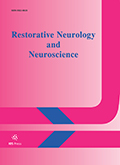Authors: Julkunen, Laura | Tenovuo, Olli | Vorobyev, Victor | Hiltunen, Jaana | Teräs, Mika | Jääskeläinen, Satu
K. | Hämäläinen, Heikki
Article Type:
Research Article
Abstract:
Purpose: To study rehabilitation outcome in a chronic visual field defect patient using positron emission tomography (PET) imaging, clinical, and neurophysiological measures. Methods: A patient with chronic visual field defect was rehabilitated using a computer program over a three-month period. Evaluations of rehabilitation effects were done before and after training, and after a three-month follow-up with perimetry, visual evoked potentials (VEP), subjective questionnaire, and PET activation studies of regional cerebral blood
…flow (rCBF). Results: In perimetry, the visual field increased during the training, and the patient also experienced subjective improvement. In VEP, a previously absent P100 component was identified after the training. In PET, increases in rCBF were diffuse immediately after the training, and more occipital after the late follow-up. A significant positive correlation between the increase in rCBF and improvement in clinical measures was found in the lingual gyrus in the contralesional hemisphere. Conclusions: All clinical measures showed improvement after rehabilitation, and this was maintained during the follow-up. In PET, a more generalized effect, found at the beginning, later concentrated in the occipital cortex. The results suggest that visual training may cause plastic changes in the brain, and that these changes can be detected both with clinical measures and with functional imaging.
Show more
Keywords: Visual field defect – chronic, stroke, rehabilitation, computer-assisted training, positron emission tomography, visual evoked potential, perimetry
Citation: Restorative Neurology and Neuroscience,
vol. 24, no. 2, pp. 123-132, 2006
Price: EUR 27.50




